
Today we’re going to take you step-by-step (and jump-by-jump) through beginner parkour training.
We’ll teach you everything you need to know (yep, even that).
A ninja costume is optional, but having fun is mandatory!
(That’s one of the cheesiest things I’ve ever typed. Sorry!)
While parkour can seem very advanced, we actually use it as a tool in our Online Coaching Program when we program workouts. Yes, you can start exercising with some basic parkour movements if being glued on a treadmill seems like death.
Here’s what we’ll cover today:
- What is parkour?
- What’s the difference between freerunning and parkour?
- Am I too old or big for parkour? (You’re not)
- Beginner training for parkour (Ninja 101)
- 4 Parkour techniques for beginners
- 6 Advanced parkour moves.
- Additional parkour resources (Next steps)
After you’re done with today’s lesson, all you’ll need is a killer soundtrack and somebody following you around with a camera to create your own epic parkour montage.
Just please don’t be like Michael, Dwight, and Andy:
What Is Parkour?
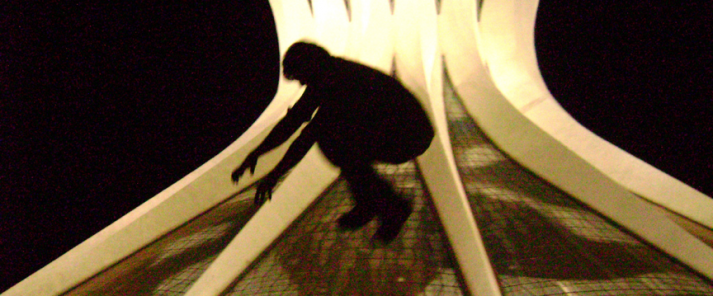
Parkour is natural, effective movement. That’s it.
Which is why we love it here at Nerd Fitness. After all, we encourage the following:
- Train naturally: Parkour is a stellar poster child for natural movement training. We encourage bodyweight training here at NF, and that’s what parkour is built around!
- Train with conviction and intelligence: Parkour’s emphasis on awareness of your environment and circumstances, as well as performance under pressure, requires as much of these qualities as you can muster, then challenges you to dig deep down and find even more.
- Train for fun: the playful and spontaneous nature of parkour encourages creativity in a way that I can only liken to improvisational jazz and dancing.
In French, the term passement is used for overcoming any obstacle. You pass or traverse a barrier in whatever way suits you and the moment; there’s no one prescribed method for anything.

Parkour is a lens of efficiency applied to every aspect of your movement through life. At its broadest definition, it implies a low-impact and considerate attitude towards bosses, co-workers, family, friends, driving, consumer purchases, and the environment (natural or manmade).
What is the least amount of effort and stuff you need in order to live the most meaningful and happy life you can make for yourself?
As with the Nerd Fitness Rebellion, it is an exuberant and responsible celebration of life.
The Difference Between Parkour and Freerunning
You’ll often hear the terms “parkour” and “freerunning” used interchangeably.
However, there are some differences worth highlighting.
- Parkour is about efficient movement through your environment, using jumps, swings, and vaults.
- Freerunning is much more about the theatrics, and you’ll find more cool-looking acrobatic movements.
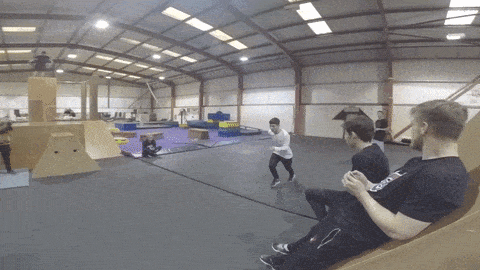
It’s not that flips, tricks, aerial acrobatics, etc, are banned from parkour. These movements can be used to traverse certain obstacles more rapidly or aggressively, but their use in parkour is ultimately dictated by need.
Will your zombie pursuers be deterred by a double front tuck flip as you clear a 14′ gap?
Or do you just need to leap and roll the gap?
Or again, maybe a quadrupedal crawl across that fallen log bridge might be best.
Success is a must, and looking cool comes from success.
People who have never done parkour (or any other high-risk physical activity) tend to see only the sensational end results on YouTube, and not the obsessive levels of meticulous and conservative training that underpin the visible final product.
Safety is huge, but ultimately a part of “effective.” The speed and airborne moves you may have seen can be a part of parkour, but are far from necessary.
Am I too old or big for Parkour? Do I have to be in shape for Parkour?
Anyone can figure out a way to traverse an obstacle.
Case in point, Emily, one of our coaching clients, started her fitness journey by training with parkour.

Emily recounts pitching the idea to her coach:
“It felt silly at first. I’m still overweight.
How could I even think about running and jumping and all that?
I braced for laughter and some gentle turn down, but Coach Matt being Coach Matt…he just got EXCITED!”
Coach Matt was thrilled Emily wanted to do some Parkour training (since he practices it himself), so he started by programing the fundamentals (more on this below).
That’s all it took to begin Emily’s Parkour obsession.
Today, Emily heads to her local park at night (like a true ninja) and practices her runs, climbs, and jumps:

So badass.
Parkour is just a mindset to find your own best way through each particular situation and moment.
From one week to the next, you could be looking at the same obstacle. But by developing a traceur’s eye (a traceur is somebody who practices parkour, by the way), you’ll begin to see different ways over or around it, depending on conditions.
Plus, as a beginner, you won’t begin by doing anything sketchy.
Emily shares, “Nobody starts by jumping scary gaps between buildings. Plenty of people in the PK community NEVER do anything even remotely dangerous.”
Even if you don’t level up to anything that’ll go viral, parkour is still a practice worth undertaking.
How Parkour Can Help You Improve Your Life

Anything we do in life can be as easy or hard as we care to make it.
Parkour just makes us realize it upfront:
- Taking five or ten seconds to set and prepare for a standing jump can be easy.
- Carefully climbing over a four-foot wall can be easy.
But when preparation time is taken away, the pressure to perform makes the same task much harder. Any traverse or passement rapidly becomes challenging when you have to do it at a dead sprint.
The hardest and most beautiful thing about parkour and other challenging activities is that they unequivocally call shenanigans on us when no one else will.
When you stand on top of a 6-foot wall and look down at the concrete or grass below, you can say whatever you like:
- “It’s easy!”
- “Man, that looks scary!”
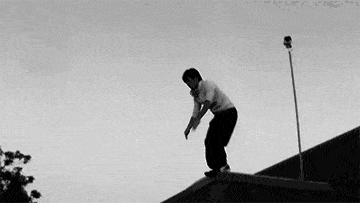
But that knot in the pit of your stomach will tell you what you really feel. Your mind will know whether you trained a hundred jumps and landings this past week, or whether you slacked off and played Xbox for three hours daily.
- If you trained up on your shorter jumps and landings, the knot will be smaller or not there at all.
- If you didn’t, the knot will be so large it’ll threaten to choke you with fear.
Good parkour is fairly easy.
Impressive, fast, and aggressive parkour is hard.
If you want to perform YouTube or District B13 (pictured below) movie-quality parkour, your typical time per passement goes from five seconds to half a second, which is a tenfold increase in difficulty.
Your methods, movements, and relative safety considerations must all adapt when your time changes.
Got it? Good!
Let’s move onto some basic training on how to get started.
Beginner Training For Parkour (Ninja 101)

If you’ve done any of our circuit workouts or bodyweight training, you’ve already begun to prepare for parkour.
Do not take my advice here as a requirement set in stone. Instead, learn your body, and you will be able to learn parkour.
Activities like yoga, lacrosse, boxing, swimming, and running (and so on) will keep your body in peak physical condition and ready for anything. I like to think of it as becoming antifragile.
Let’s start with some moves to help you build up some strength.
The Parkour Workout for Beginners:
#1) Bodyweight Squats: 10 reps

#2) Push-ups: 10 reps

#3) Leg lifts: 10 reps (each leg)
#4) Pull-ups: 10 reps

If you can’t do a pull-up, no problem. Start with bodyweight rows:

Here’s how to get your first pull-up if you’re interested.
Do two sets of this list, every other day. If some or all of this list is too hard, reduce your reps per set for the hard exercise(s) until you can do two sets.
It’s also OK to start with knee push-ups or assisted bodyweight squats – you can find easier versions of all these moves at The 42 Best Bodyweight Exercises.
The important thing is to do more next week than you can this week.
Here’s how to progress:
- Each week, add 1-2 reps to each exercise (2×12, 2×14, 2×15, etc.)
- After doubling the reps for each exercise (2×20), add another full set to your workout (3×20; you may have to temporarily reduce reps on that final set back down to 10 or less).
- When you can do 4×20, perform each rep a little faster, more explosively, to get in a more plyometric and aerobic workout.
“Plyometric” are exercises where muscles exert maximum force, in short intervals of time. Think “explosive” here, which is critical for parkour.
To make these moves more “plyometric,” you can swap regular push-ups for the explosive kind:

Your squats can become jump squats:
That will help you develop the power you need to overcome obstacles.
Bodyweight exercises may seem really easy, but they provide a base level of strength for more advanced parkout maneuvers.
Want some more help starting with bodyweight training?
Download our free worksheet for the Beginner Bodyweight Workout, for training that can be done in the comfort of your home or a park today! Get it free when you sign up in the box below:
- Complete this workout at home, no equipment required
- Avoid the common mistakes everybody makes when doing bodyweight exercises
- Learn how to finally get your first pull-up
4 Moves for Beginner Parkour: Jumps, Landings, Vaults, and Muscle-ups
Now it’s time to learn some parkour moves.
Let’s start with our jumps.
First, practice your jump squat:

Then, you can work on a broad jump:
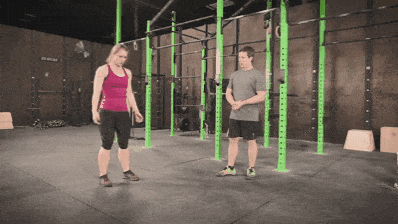
Then, we’ll want you to train jumping upward, with box jumps:

After you become comfortable with basic jumps, it’s time to leap over some obstacles.
We’ll start with stairs.
Find some stairs or outdoor steps, and practice jumping with your whole body. Jump from the ground up to one step, then two, then three, etc.
You should be relaxed, well-balanced with a relatively upright posture, and land softly on your toes 10 times in a row before you add another step to your jumps the next session or week:
- 1-2 steps are fairly easy
- 3-4 is a moderate challenge
- 5-6 is difficult
- 7 steps or more probably isn’t happening.
Here’s a great video highlighting some beginner parkour stair exercises:
Stairs aren’t the only obstacle you’re going to need to overcome with parkour.
Any beginner traceur will be comfortable doing four moves to navigate their environment:
- Landing
- Two-Handed Vault
- The Muscle-Up
- A Precision Jump
Let’s go over each of these beginner parkour moves now.
These videos are all courtesy of American Parkour.
Beginner Parkour Move #1: Landing Properly
Beginner Parkour Move #2: Two-Handed Vault
Beginner Parkour Move #3: The Muscle-Up
Beginner Parkour Move #4: Precision Jump
How to do More Difficult Parkour Moves
Here’s a great video showcasing solid parkour skills without being too flashy:
Brilliant. This is what parkour should look like.
No flips, no huge gap-clearing launches into empty space, just a lot of little things that add up to efficient zombie-fleeing movement…after all, you never know when that zombie apocalypse may strike 🙂
Before you jump into a sequence like this, make sure you’re comfortable with the basics, like the muscle-up:
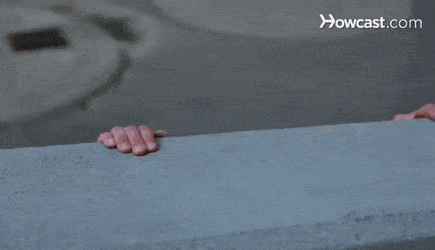
You should be able to do our 4 beginner moves (Landing, Two-Handed Vault, Muscle-Up, and Precision Jump) over and over again.
Hundreds of reps of full-body exercises will help strengthen all your minor stabilizers and oblique muscles that you don’t think about.
All it takes is one weak muscle getting pulled to ruin your day. For you to stay safe and minimize the damage and injury from stumbles and falls, you need to be as fit as you can afford to be (in terms of time and willingness).
You will be the best judge of doing only what is within your ability.
If you want to flip and vault off monkey bars, be prepared to spend many hours at a gymnastics gym.
Want to Kong Vault over a picnic table or other object?

Then be prepared for thousands of clapping push-ups. This trains not only the strength but the reflexes to use those muscle motions in the 0.1 second when you trip on a wall or rail in mid-air and come tumbling down.
Reports of bone breaks, sprains, and concussions are not uncommon with parkour. However, they are almost always because someone got a little overconfident and pushed beyond their current training and ability. Respected traceurs may not be flashy, could they can also report not breaking any bones in their years of training.
I’ll take that win every single day.
Before we bring up some advanced techniques, you should be able to regularly perform these exercises with ease:
- Jump up at least 24” and grab an overhead rail or ledge for a casual pull-up.
- Jump and tuck your knees to land gently on a bench or a picnic table.
- Broad jump 4-6’ with good balance on landing.
- A set of plyometric push-ups.
Did you get that down no problem? Awesome…now let’s do some fun stuff.
Advanced Parkour Training Techniques
Shoulder rolls are your absolute top face-saver and pain-preventer. Choosing to do them well isn’t important. Falling and rolling when completely surprised and off-balance is what’s important.
Tuck your head and hands in, relax your body, arc your arms and one shoulder forward in a hula hoop shape around your head, and roll your butt over your head.
To do the parkour roll:
Here’s the rest of the APK parkour tutorial channel, with videos covering these foundation parkour movements (listed in approximate order of increasing difficulty and greatest to least utility):
Advanced Parkour Move #1: Wall Run
Advanced Parkour Move #2: Cat Leap
Advanced Parkour Move #3: Cat Balance
Advanced Parkour Move #4: Monkey Vault
Advanced Parkour Move #5: Kong Vault
Advanced Parkour Move #6: Tic-Tac
Want some more?
Work through Demon Drills’ category of videos.
Try everything once slowly. Skip anything that’s too challenging, and come back to it in a week or so.
Parkour is a highly personal form of self-expression and choice, and it demands a fine sense of body awareness. Your body can only be as strong as its weakest muscle when it comes to parkour, so make sure you are well balanced.
More Parkour Resources and Motivation

Ready to get started? Good, now watch a few more videos for motivation and inspiration:
After that, head outside, start practicing your movements and look for other traceurs in your area. A simple google search for “parkour” or “free-running” plus your town name will generally turn up a group that practices in your area.
That should help you get started.
If you want to continue your journey with Nerd Fitness, I’ve got three options for you:
Option #1) If you’re reading this because you know you need to exercise, but don’t want to get bored in a gym, I hear ya. My own personal torture is being stuck on a treadmill! If you’re trying to lose weight and want somebody to guide you through the entire journey, who will ALSO never make you do any exercises you hate, consider checking out our popular 1-on-1 Coaching Program.
2) If you want a daily prompt for doing workouts at the gym (or at home), check out NF Journey. Our fun habit-building app helps you exercise more frequently, eat healthier, and level up your life (literally).
Try your free trial right here:
Option #3) Become part of the Rebellion! We need good people like you in our community, the Nerd Fitness Rebellion.
As I pointed out earlier- if you’re just getting started with parkour, I would make sure you begin with bodyweight training! If you sign up for our newsletter, I’ll send you a worksheet for our Beginner Bodyweight Workout that you can follow at home:
- Complete this workout at home, no equipment required
- Avoid the common mistakes everybody makes when doing bodyweight exercises
- Learn how to finally get your first pull-up
Okay, enough reading, go start practicing!
Viva la Rebellion!
-Steve
PS: If you’re looking for more creative ways to move your body, check out 40 Ways to Exercise Without Realizing It!
###





